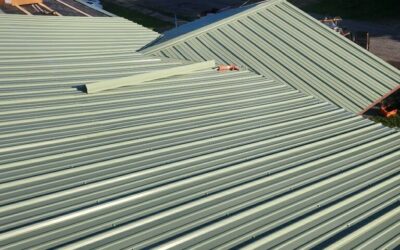When Is the Best Time of Year to Replace a Commercial Roof?
Replacing a commercial roof is a major investment for any business owner. The timing of the replacement can have a significant impact on cost, efficiency, and the lifespan of your new roof. For business owners in Northeast Ohio, understanding how seasonal weather affects commercial roofing projects is essential to make informed decisions.
At S&K Construction and Remodeling LLC, headquartered in Jefferson, Ohio, we specialize in commercial roofing solutions and have extensive experience guiding businesses in Ashtabula, Madison, Youngstown, Cleveland, Mentor, Chardon, and surrounding areas. This blog explores the best time of year to replace a commercial roof, factors to consider, and why professional installation is critical for long-lasting results.Commercial roof replacement in Ohio when and where is the best time to achieve the work to be completed.
1. Why Timing Matters for Commercial Roof Replacement
Commercial roofs are subject to harsh weather conditions year-round, including heavy snow, ice, strong winds, and summer heat. These conditions not only impact the installation process but also affect:
- Material performance – Some roofing materials require specific temperature ranges for adhesives or membranes to cure properly.
- Labor efficiency – Working in extreme heat, cold, or wet conditions can slow progress and increase labor costs.
- Structural safety – Ice, snow, and water accumulation can create unsafe conditions on the roof.
- Overall cost – Contractors may adjust pricing based on demand, weather, and risk factors associated with each season.
Choosing the right season ensures your roof is installed efficiently, performs as intended, and lasts for decades.
2. Spring: Ideal for Roof Replacement
Spring is often considered one of the best times of year to replace a commercial roof in Ohio. The weather is generally mild, making it easier for roofing materials to perform as expected.
Benefits of Spring Installation
- Moderate temperatures create ideal conditions for adhesives, sealants, and membranes.
- Snow and ice are usually melted, reducing safety risks.
- Contractors have availability before the busy summer season.
- Rainfall is common but manageable with proper planning and waterproofing measures.
Spring installation allows businesses to prepare their roof for summer storms, ensuring maximum protection during the season when heavy rains and wind events are more frequent.
3. Summer: Efficient but Hot
Summer is another popular time for commercial roof replacements, but it comes with considerations specific to Northeast Ohio.
Advantages of Summer Installation
- Long daylight hours allow crews to work longer days and complete projects faster.
- Warm weather ensures adhesives and sealants cure quickly.
- Minimal risk of snow or ice interfering with installation.
Challenges of Summer Installation
- High temperatures can make roofing membranes more pliable, but extreme heat can also cause discomfort for workers and affect material handling.
- Afternoon thunderstorms are common in Ohio, which can delay projects.
- Busy season for contractors may result in higher labor costs or limited availability.
Summer is suitable for commercial roofing experts if your business can coordinate schedules and plan for occasional weather delays.
4. Fall: Optimal for Weather-Sensitive Projects
Fall is often considered the most favorable season for commercial roof replacement in Ohio. Temperatures are moderate, humidity is lower, and severe weather is less common.
Benefits of Fall Installation
- Mild temperatures allow for proper adhesion and curing of roofing materials.
- Lower humidity reduces the risk of moisture-related issues.
- Contractors often have more availability after the summer rush.
- Roofs installed in the fall are ready for winter weather, including snow and ice.
Fall is especially ideal for flat roofs with membranes like EPDM, TPO, and PVC, as cooler temperatures reduce the risk of blistering or adhesion failure.
5. Winter: Challenging but Possible
Winter is the least ideal season for roof replacement in Northeast Ohio due to snow, ice, and freezing temperatures. However, with careful planning and experienced contractors, winter installation is sometimes feasible.
Challenges of Winter Installation
- Adhesives and sealants may not cure properly in freezing temperatures.
- Snow and ice accumulation create safety hazards for roofing crews.
- Cold temperatures can make membranes stiff and difficult to handle.
- Projects may take longer, increasing labor costs.
When Winter Installation Makes Sense
- Emergency roof replacements due to storm damage
- Leaks or structural issues that cannot wait until spring
- Buildings with flat roofs that have minimal snow accumulation and can be cleared safely
Professional roofing contractors like S&K Construction and Remodeling LLC can take precautions, use specialized equipment, and select materials suitable for winter installations.
6. Material Considerations by Season
The type of commercial roofing material also influences the best installation timing:
| Material | Best Season | Notes |
|---|---|---|
| EPDM Rubber | Spring/Fall | Cold weather makes membranes stiff; hot weather can soften seams |
| TPO | Spring/Fall | Adhesion is temperature-sensitive; moderate weather ensures proper bonding |
| PVC | Spring/Fall | Heat-welded seams work best in moderate temperatures |
| Modified Bitumen | Spring/Summer | Torch-down and cold-applied options require dry conditions |
| Built-Up Roofing (BUR) | Spring/Summer | Hot asphalt and layers require favorable temperatures |
Choosing the right season for your roofing material ensures the adhesive cures correctly, seams seal properly, and the roof performs optimally.
7. Other Factors to Consider When Scheduling a Replacement
1. Business Operations
- Plan roof replacement during low-traffic periods to minimize disruption.
- Schedule interior work (like insulation or electrical adjustments) around the replacement timeline.
2. Contractor Availability
- Busy seasons may limit the availability of experienced crews.
- Booking early ensures your project is prioritized and completed efficiently.
3. Weather Forecast
- Avoid periods with high rainfall or expected storms.
- Check historical weather patterns for your area to anticipate potential delays.
4. Budget Considerations
- Off-season projects may provide cost savings due to lower labor demand.
- Avoid emergency replacements, which often come at a premium cost.
8. Why Professional Installation Matters
Even the best timing cannot compensate for poor workmanship. Commercial roofs require proper installation to ensure durability, performance, and compliance with manufacturer warranties.
At S&K Construction and Remodeling LLC, we provide:
- Free inspections and estimates for commercial roof replacements
- Expert installation of EPDM, TPO, PVC, and modified bitumen roofs
- Compliance with manufacturer specifications to maintain warranties
- Storm damage repair and insurance claim assistance
- Service throughout Northeast Ohio, including Ashtabula, Madison, Youngstown, Cleveland, Mentor, and Chardon
Professional installation ensures that your roof performs reliably, no matter the season.
9. Preparing Your Commercial Roof for Replacement
Proper preparation is key to a successful commercial roof replacement:
- Inspect the existing roof for leaks, ponding water, and structural issues
- Clear debris and obstructions before installation
- Schedule inspections for roof penetrations like HVAC units, vents, and skylights
- Confirm proper drainage to prevent ponding on flat roofs
S&K Construction and Remodeling LLC provides thorough pre-installation inspections and preparation, ensuring your new roof is durable and long-lasting.
10. Conclusion: Timing Your Commercial Roof Replacement Wisely
The best time to replace a commercial roof in Ohio depends on several factors, including weather, roofing material, business operations, and contractor availability. In general:
- Spring: Ideal for moderate temperatures and preparing for summer storms
- Summer: Efficient for longer workdays but requires planning for heat and thunderstorms
- Fall: Often optimal for mild temperatures, low humidity, and pre-winter readiness
- Winter: Feasible only for emergencies or with specialized contractors
Regardless of the season, proper preparation, high-quality materials, and professional installation are critical for long-term performance.
If your commercial roof is nearing the end of its lifespan or has sustained storm damage, contact S&K Construction and Remodeling LLC today. Serving businesses across Northeast Ohio, we provide free inspections, expert recommendations, and high-quality commercial roof replacements designed to last for decades.
Timing your replacement correctly, combined with professional installation, ensures your business is protected from leaks, structural damage, and costly repairs—no matter what the Ohio weather brings. commercial roofing services
I
 (440) 307-2060
(440) 307-2060




